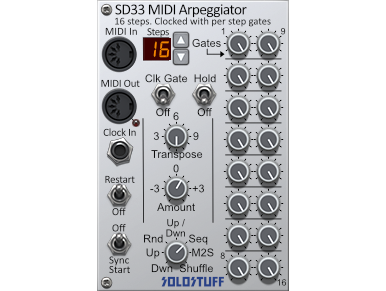Product Description
(This module is included in the System B)
The SD33 is a MIDI arpeggiator with a bit more than the typical features of an arpeggio under it’s belt. A Clock In controls the speed. Note that this doesn’t need to be a clock literally. It can be any trigger input. Be it an LFO, manual trigger, even VCO!!. You can for example use the SB12 triggers to get unusual arpeggio rhythms.
At the middle bottom, exists the pattern knob with Up, Dwn, Rnd, UpDwn, Seq, M2S and Shuffle patterns. Most of them are self explanatory once you try them. Seq (Sequence) pattern turns the module into a sequencer which means it will play notes it receives in the order they were received in. M2S (Middle to Sides) does what it names says. The Shuffle pattern chooses a random sequence and sticks with it. This is different than the Rnd (Random) pattern which changes all the time. If you want to change the Shuffle pattern just turn the knob to a different setting then return it back to Shuffle. Notice that Shuffle doesn’t repeat notes while Rnd does repeat notes.
There are 16 step gate knobs that define the gate length of each note played. The Steps display determines the number of step gate knobs used before it repeats/restarts.
The Transpose and Amount knobs work together. Essentially they ADD more notes to the arpeggio. Transpose is in semi tones. Amount is how many notes to add per incoming note. If Amount is negative, lower pitch notes are added. If Amount is zero no notes are added. These two knobs are better understood when they are tried. By default, Transpose is set to the maximum of 12 semitones (octave) which is what most other arpeggiators do for their well known “octave” function that adds notes in octaves.
The Restart/Off switch will cause the whole arpeggio to restart from the first gate step when newly pressed MIDI notes come in WHILE there is no current note(s) playing. The Sync Start/Off switch will force the first step to always sync with the incoming clock regardless of when the notes are played. Hold/Off will cause the arpeggio to hold and keep playing the notes even if the notes were depressed (note off). This is also useful for easily recording sequences in Seq pattern. The Clk Gate/Off switch disables all the gates knobs and takes the note gate from the incoming clock gate!!. This is useful if you want to control the gating time using another module, for example the S705
Tip: Put two arpeggiators in series and clock them differently and play with hold and other knobs. You can get interesting results.


Reviews
There are no reviews yet.